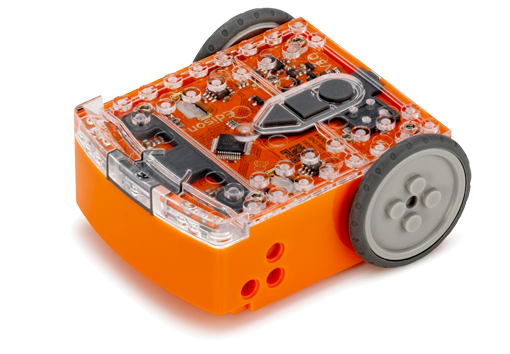Once your Edison robot has been set up correctly, Edison requires very little ongoing maintenance, but there are a few tricks to ensure everything works just right every time. Learning these six tricks will make you a master of Edison dos and don’ts – setting you up for success each time you use your robot.
1. In terms of batteries, Edison always checks the ingredients
It’s not saturated fat Edison is avoiding, but this little robot still wants you to read the label before you buy batteries. If using disposable batteries with Edison, only ever use alkaline batteries. (These are the most common AAA batteries you will find in just about any shop.) If you are using rechargeable batteries with Edison, only use nickel-metal hydride (NiMH) rechargeable batteries. Never use heavy-duty, super heavy-duty or carbon-zinc batteries. Either way, make sure they are fully charged. Low or flat batteries can cause some weird behaviour from Edison, resulting in a range of issues with the robot.
Just as important as the type of batteries is the way you present them to Edison. In other words, always make sure the batteries are inserted correctly. You will find detailed pictures in our Getting started with Edison guide.
2. Edison, without you, is a bit of a dummy
Your Edison robot will always do exactly what you tell it to do. This means that if you program Edison to ‘drive’ but don’t tell Edison how far to go or to stop, Edison simply doesn’t know these things. Instead, Edison will just drive… possibly straight into a wall.
If you are having problems with Edison not doing what you expect, double check your program. There may be something missing or another logical error causing your robot to misbehave.
3. Edison rocks out with the volume all the way up
It’s a good thing Edison doesn’t have ears because this robot would almost certainly be considered a bit deaf! Edison needs the volume on your programming device turned up all the way in order to ‘hear’ the program download. Many devices automatically lower the volume when an audio device, like the EdComm cable, is detected in the audio jack, so be sure to double-check the volume is turned up to full after you plug in the EdComm cable.
4. When it comes to sunlight, treat Edison like a vampire
If you put Edison in direct sunlight, the robot’s sensors are bombarded with light and will most likely fail to work correctly. This can cause problems when trying to read barcodes, follow lines, avoid obstacles or respond to visible light.
As a general rule of thumb, it’s best to avoid using Edison in bright, direct sunlight.
5. Using line tracking? Edison plays chess rules
Whenever you are using Edison’s line tracking sensor, remember that white always goes first. In other words, always start Edison on the white surface, not the black surface.
Why is this?
Edison’s line tracking sensor uses reflected light readings to find the difference between white and black surfaces. Edison takes an initial reading of reflected light against the surface the robot starts on. Edison then uses this reading as the reading of a reflective surface – it equates this as the brightest thing it will see. Edison then looks for a sharp drop-off in the reflected light readings it receives. The robot equates that sharp drop-off as being the non-reflective surface. If you start Edison on top of a black line, Edison reads that line as the ‘brightest thing’. When the robot then turns onto the white surface and gets a higher value, it doesn’t understand what is going on and ends up spinning on the spot.
6. Edison can see invisible light (so long as it’s bouncing back)
Edison has an infrared (IR) light detection system. While infrared light is invisible to humans, Edison can detect this light with the IR sensor located at the front of the robot. This system allows Edison to work with TV/DVD remote controls, communicate with other Edison robots and detect obstacles.
In terms of obstacle detection, the IR system sends out infrared light and checks to see if any of that light is bounced back. This is how the robot can identify obstacles. Which also means, for the system to work properly, Edison needs the light to actually bounce back.
Very dark coloured objects, such as objects that are totally black, absorb most of the IR light, making it hard for Edison to detect them. On the other hand, transparent and translucent obstacles allow virtually all of the IR light to pass straight through, meaning nothing bounces back for Edison to detect.
Instead, choose obstacles that are opaque but not too dark and at least as tall as Edison.
If Edison is still struggling to detect your obstacles, you may also need to calibrate your robot’s obstacle detection. You can find the barcode you will need and step-by-step instructions on the barcodes page.
Be sure to download the free Getting started with Edison guide and checklist for even more great advice.



Excellent tips especially about the light. I always warn users to look at reflected light which might get under the Edison when they are doing a download as it can interfere with the download process especially near windows and doors.
We seem to be losing skids on a number of our units and have had to order replacement parts. We are not sure if they are simply falling off or have become the victim of curious fingers. Regardless, does anyone have suggestions regarding how to avoid this problem. Would a drop of plastic glue when a skid is replaced work?
Hi Thomas,
Thank you for contacting Team Edison. My name is Hamish and I will help you with your query.
You could well be right that you have become the victim of curious fingers in relation to your lost skids. However, here are a few tips to hopefully prevent anymore needless loses:
Always make sure the skids are fully installed into your Edison, you should hear a distinctive ‘click’ when you re-install it
Try to limit the use of Edison on carpet, particularly when running drive programs, Edison seems to work better on hard surfaces either way
If you were really worried you could limit the amount of times that you take the skid in and out of the robot and as you say even glue it down. I would point out that some activities such as EdCreate do require the skid to be removed so it may not be the most ideal solution.
Best of luck!
Can you confirm the spec of the voltage regulator? How well do NiMH actually hold up over time in thinking about the frequency of recharging vs how long alkaline might last. Clearly 4x 1.2v NiMH is only 4.8v. What is the reasonable usage threshold on voltage?
Hi Todd, our technical support team have advised the following:
“The voltage regulator is a 3.3v regulator spec.
Unfortunately we can’t answer the question: “How well do NiMH actually hold up over time in thinking about the frequency of recharging vs how long alkaline might last”
because it will be dependent on the brand of both types of batteries and likely the method used to charge the NiMH (both in terms of equipment used and how drained they get before being charged).
4.8v is in the usable voltage range for Edison.”
If you have any additional technical support questions please do not hesitate to reach out to our team at https://meetedison.com/edison-robot-support/contact-us/
I recently bought two V.2 Edisons for our class, but after a few succesful lessons, both Edisons have somehow bugged out on us. Whenever we pressed the “record” button, it would shut down without any further lights flashing or any response. We tried changing the batteries but without success. The worst thing is, it happens only in around 95% of the time, so after a dozen restarts, it goes into recording mode properly. Anyone else had the same issue? Thx
Hi Mark, Is there any chance that you are using Edison V2 in a bright room with perhaps sunlight coming in? Edison V2’s line tracking sensor does not like sunlight and if it receives too much it thinks it is going into EdComm programming mode. Try moving away from direct sunlight and try again.